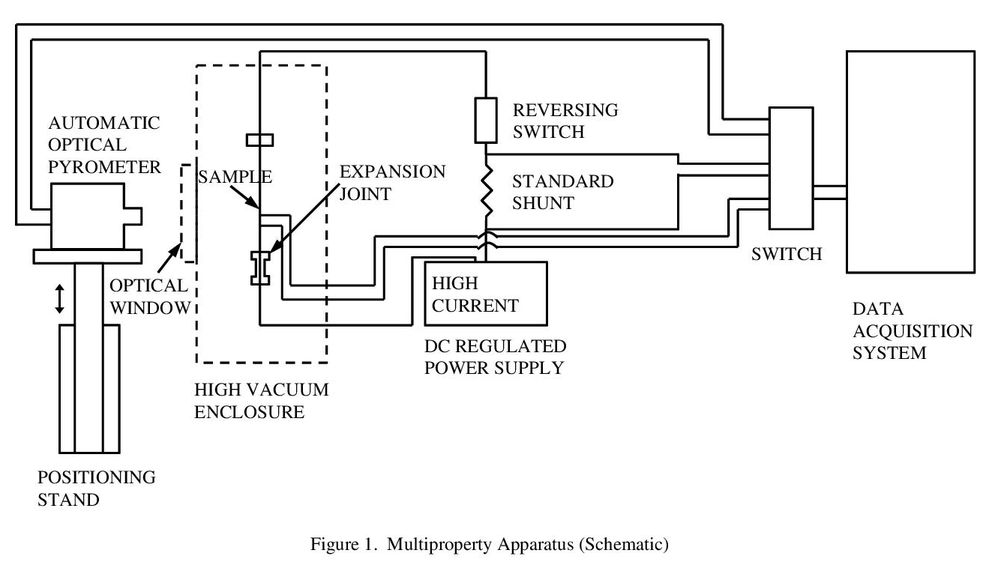Thermophysical Properties Research Laboratory, Inc.

Phone : 765-463-1581
Multi-Property Apparatus
(ASTM B 193-02, ASTM C 835-06)
The multiproperty apparatus is designed to measure many thermophysical properties, including thermal conductivity, thermal diffusivity, specific heat, thermal expansion, electrical resistivity, emissivity, enthalpy, hemispherical total emittance, Wieddemann-Franz-Lorenz Ratio, Thomson coefficient, Seebeck coefficient, Peltier coefficient, and Richardson coefficient. The samples used in the multi-property apparatus must be rod-shaped materials which are reasonable electrical conductors. Metals, alloys, and graphitic materials have been measured extensively using this device. Measurements of most of these properties can be made from room temperature to about 1000°C using thermocouples for temperature measurement. However, the apparatus is primarily a high temperature (>1000°C) device using optical pyrometry for temperature determinations.
Temperature Range
The temperature range of the multi-property apparatus is room temperature to an upper temperature limitation imposed by the samples material characteristics, i.e., vapor pressure, melting temperature, softening temperature, etc.
Environment
The multiproperty apparatus consists of a high vacuum system (10-7 torr), large bell jar equipped with two long windows, interior piping and sample holders with provisions for sample expansion and contraction, and regulated DC power supplies. An automatic optical pyrometer and elevating stand are required, and twin telemicroscopes and stand are used for thermal expansion. Samples in the form of thin rods, tubes, or wires are supported vertically between water-cooled movable electrodes. The electrode separation distance is adjustable between 0 and 14 inches. Sample expansion and contraction is maintained stress-free through a spring network mounted on a movable "c-cell" equipped with strain gauges. The bell jar which covers the sample support system is raised and lowered by a hoist. The bell jar rests on a feed-through collar which contains rotary feed-through's for protecting the window and for moving the c-cell, instrumentation leads, electrical connections, and water lines. Usually instrumentation readout is accomplished using a minicomputer based digital data acquisition system. The bank of regulated power supplies is equipped with remote controls, reversing switches and calibrated current shunts. Temperature measurements are made using the automatic optical pyrometer mounted on a positioning stand external to the vacuum system and viewing the sample through an optical window. The system is shown schematically in Figure 1. Linear thermal expansion measurements use twin telemicroscopes mounted on a second stand and viewing the sample through a second window.

Procedure
Before the sample is inserted into the multiproperty apparatus, several preliminary steps should be taken. The sample's diameter should be measured, the sample weighed, voltage probe wires or fiducial marks (thermal expansion) attached, and the separation distances between voltage probes or fiducial marks determined. The electrical resistivity determined along various portions of the sample also serves as a check of homogeneity and is valuable in determining changes in the sample caused by high temperature heating.
Place the sample into the test cell, lower the bell jar, and create a vacuum. Using high-current, low-voltage supplies, adjust the sample temperature to the desired level by adjusting the current. At the desired temperatures, measure the voltage drop across the probes (V), the current (I), and the uniform central temperature (T). The electrical resistivity (ρ) can be calculated with the following equation:
(ASTM B 193-02, ASTM C 835-06)
The multiproperty apparatus is designed to measure many thermophysical properties, including thermal conductivity, thermal diffusivity, specific heat, thermal expansion, electrical resistivity, emissivity, enthalpy, hemispherical total emittance, Wieddemann-Franz-Lorenz Ratio, Thomson coefficient, Seebeck coefficient, Peltier coefficient, and Richardson coefficient. The samples used in the multi-property apparatus must be rod-shaped materials which are reasonable electrical conductors. Metals, alloys, and graphitic materials have been measured extensively using this device. Measurements of most of these properties can be made from room temperature to about 1000°C using thermocouples for temperature measurement. However, the apparatus is primarily a high temperature (>1000°C) device using optical pyrometry for temperature determinations.
Temperature Range
The temperature range of the multi-property apparatus is room temperature to an upper temperature limitation imposed by the samples material characteristics, i.e., vapor pressure, melting temperature, softening temperature, etc.
Environment
The multiproperty apparatus consists of a high vacuum system (10-7 torr), large bell jar equipped with two long windows, interior piping and sample holders with provisions for sample expansion and contraction, and regulated DC power supplies. An automatic optical pyrometer and elevating stand are required, and twin telemicroscopes and stand are used for thermal expansion. Samples in the form of thin rods, tubes, or wires are supported vertically between water-cooled movable electrodes. The electrode separation distance is adjustable between 0 and 14 inches. Sample expansion and contraction is maintained stress-free through a spring network mounted on a movable "c-cell" equipped with strain gauges. The bell jar which covers the sample support system is raised and lowered by a hoist. The bell jar rests on a feed-through collar which contains rotary feed-through's for protecting the window and for moving the c-cell, instrumentation leads, electrical connections, and water lines. Usually instrumentation readout is accomplished using a minicomputer based digital data acquisition system. The bank of regulated power supplies is equipped with remote controls, reversing switches and calibrated current shunts. Temperature measurements are made using the automatic optical pyrometer mounted on a positioning stand external to the vacuum system and viewing the sample through an optical window. The system is shown schematically in Figure 1. Linear thermal expansion measurements use twin telemicroscopes mounted on a second stand and viewing the sample through a second window.

Procedure
Before the sample is inserted into the multiproperty apparatus, several preliminary steps should be taken. The sample's diameter should be measured, the sample weighed, voltage probe wires or fiducial marks (thermal expansion) attached, and the separation distances between voltage probes or fiducial marks determined. The electrical resistivity determined along various portions of the sample also serves as a check of homogeneity and is valuable in determining changes in the sample caused by high temperature heating.
Place the sample into the test cell, lower the bell jar, and create a vacuum. Using high-current, low-voltage supplies, adjust the sample temperature to the desired level by adjusting the current. At the desired temperatures, measure the voltage drop across the probes (V), the current (I), and the uniform central temperature (T). The electrical resistivity (ρ) can be calculated with the following equation:
ρ=(A/L)(V/I)
εH=(VI)/[PLσ(T4-T04)]

Copyright 2018 TPRL, Inc.
3080 Kent Avenue
West Lafayette, IN 47906
3080 Kent Avenue
West Lafayette, IN 47906
Last updated 12/22/2017





